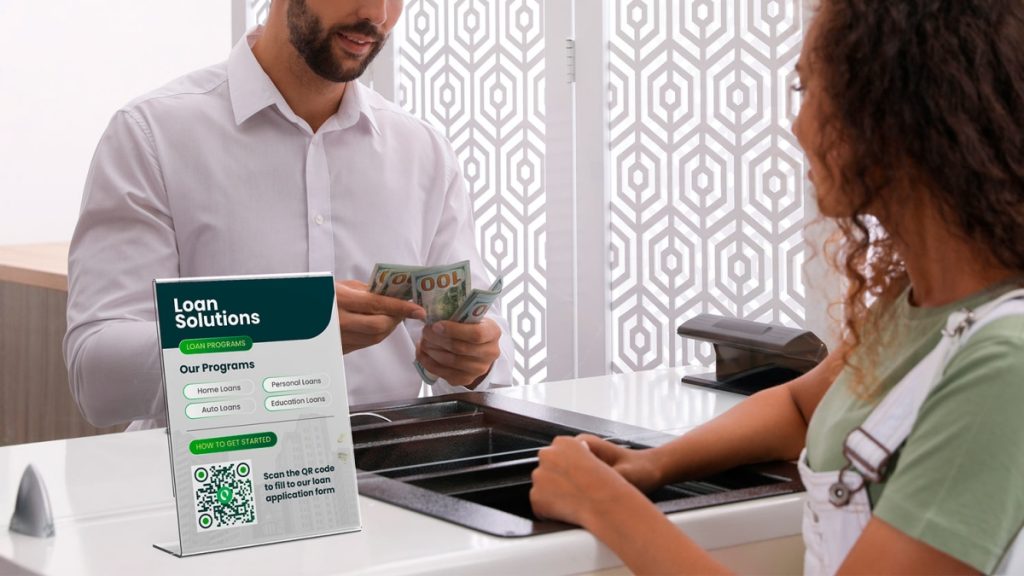Loan applications should be quick and hassle-free, but many traditional processes often aren’t.
Clients frequently experience extended wait times, complete extensive documentation, and encounter the unavoidable setbacks and mistakes associated with manual data input. These inefficiencies frustrate borrowers and hinder banks’ and lenders’ approval processes.
Upgrade your system with tools like a QR code loan application form for banks; the entire process can be streamlined, cutting down on paperwork and wait times.
Banks and customers can now enjoy a faster, user-friendly application experience. With just a scan of a code, customers can access their form instantly, eliminating the need for physical documents.
Implementing QR codes in loan application processes is a promising way to modernize banking operations.
While the technology has clear advantages, its effectiveness depends on proper implementation and addressing the needs of all users. Let’s explore its benefits and the realities of integrating QR-based systems.
How a Form QR Code Generator Can Simplify Loan Applications
A QR code form generator combines a form builder and a QR code generator within one platform. It addresses the increasing demand for tools that simplify form creation while enabling real-time tracking and analytics.
With this integrated approach, businesses can generate QR codes that link directly to customized forms while tracking key metrics such as scan locations, frequency, and devices used—everything managed from a single interface.
QR code loan application forms simplify certain steps in the process:
Convenience for Customers: Scanning a QR code to access a form removes the need for physical paperwork, reducing clutter. Customers can complete the application from their smartphone, at home, or in a bank.
Efficiency for Banks: Digital submission eliminates hard-to-read handwriting and speeds up processing by providing structured data.
That said, it’s not a magic fix for every problem. Implementation must account for users without smartphones, those unfamiliar with technology, or locations with poor internet connectivity. Staff support will remain critical for ensuring accessibility to all customers.
Building an effective loan application form for banks
Banks need the right tools to create an effective and efficient loan application form. Effective ones that provide a smooth experience for the institution and its customers.
A QR code form generator is one such tool that helps simplify the process by allowing customers to scan a code and instantly access the application form.
Features
Branding: Personalize the form to reflect your bank’s branding by adding logos, colors, and fonts. This ensures a professional and consistent look that customers recognize.
User-Friendly Interface: Keep the form simple and easy to navigate, reducing the chance of errors and making it quicker for customers to complete.
Ready-Made Templates: Take advantage of loan form templates, which offer standard fields commonly required in loan applications. Customizing these templates gives you a head start, saves time, and serves as a guide to ensure all necessary information is collected.
How to create a QR code form
- Go to the QR Form Generator Website
- Login/Register & Access the Form Builder Interface: Log in to your account or create a new one to access the form-building interface where you can begin designing your form.
- Build and Design Your Form: Add the necessary fields for your loan application. You can use templates to speed up the process. Remember to add your bank’s logo for branding to give your form a professional, cohesive look.
- Click “Generate QR Code: Once the form is ready, generate a unique QR code that links directly to your customized form.
- Design the QR Code: Customize how your QR code looks by adjusting the pattern, eyes, and frame and add your brand’s logo.
- Test It on All Mobile Devices: Before going live, test the form by scanning the QR code on various mobile devices to ensure it functions smoothly across all platforms.
- Download: After confirming everything is in order, download the QR code and form data. Tip: Download the data as a CSV file to preserve the quality of the form, regardless of size.
QR forms in practice
To better understand how QR forms can streamline the process, consider the following example:
Imagine a bank placing a QR code in its branch or website. Instead of filling out a paper form—often prone to erasures or difficult-to-read handwriting—customers scan the code with their smartphone.
They are then directed to an easy-to-complete loan or credit application form, which they can complete at their convenience. Once submitted, they receive a priority number, reducing the time spent waiting in line or sitting at a desk.
In addition, customers can upload any necessary loan requirement documents directly through the form, provided the documents are of good quality. This eliminates the need to bring physical copies into the bank.
This approach improves efficiency and reduces errors commonly associated with manual forms.
While the process is simplified for most, staff will still be available to assist customers who need extra help, such as those with disabilities, senior citizens, or customers unfamiliar with the process, ensuring that no one is left behind.
QR loan application form in banks: gimmick or innovation?
The shift to a QR code loan application form for banks is more than just a gimmick—it’s a smart move for any bank or lender looking to streamline their operations and improve customer experience.
Adopting QR forms reduces the hassle of paperwork, minimizes errors, and offers a faster, more secure loan application process.
However, their success depends on thoughtful implementation. They must address potential challenges, such as accessibility issues and technical support, to ensure they benefit all users.
Instead of seeing QR forms as a replacement for traditional methods, think of them as a complement to existing processes. With proper planning, they can be a step forward for banks striving to serve their customers better.
Don’t just take our word for it—test it out and see the results!




